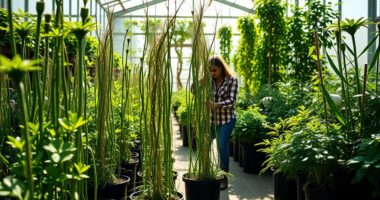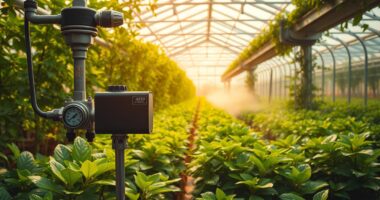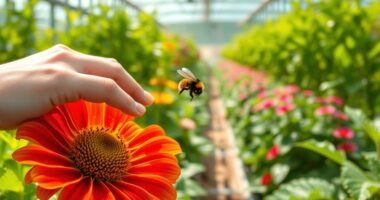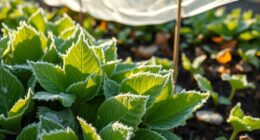When transplanting seedlings into your greenhouse, timing is key—make sure soil temperatures are right for your crops. Prepare by using sterilized containers and enriching the soil with compost. Handle seedlings gently to prevent damage, and transplant them during cool, early mornings. After transplanting, monitor moisture and temperature closely to keep them thriving. If you're keen to learn more about enhancing your greenhouse efficiency, there's a lot more to explore.
Key Takeaways
- Monitor soil temperatures to ensure ideal conditions for transplanting; cool-season crops need 40°F, while warm-season crops require over 59°F.
- Select appropriately sized containers with drainage holes and use a high-quality, well-aerated potting mix enriched with organic matter.
- Handle seedlings carefully by their leaves, ensuring they are well-watered before transplanting to reduce stress and prevent damage.
- Transplant seedlings during the early morning for optimal temperature and humidity, using dibble holes for precise placement.
- After transplanting, regularly check for pests, manage moisture levels, and adjust light to support healthy growth.
Optimal Timing for Transplanting Seedlings
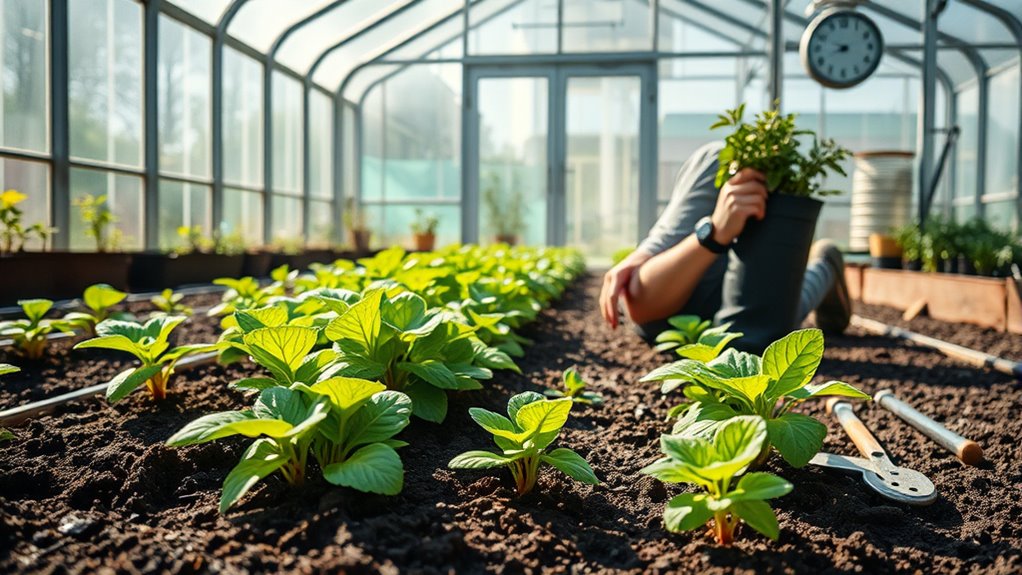
When you're planning to transplant seedlings into your greenhouse, timing is essential for their success. You need to monitor soil temperatures closely.
Timing is crucial when transplanting seedlings; closely monitor soil temperatures for optimal success.
For cool-season crops, like cabbage and broccoli, wait until soil temperatures reach around 40°F (4°C). For warm-season plants, such as tomatoes and peppers, make sure the soil is above 59°F (15°C) before you transplant.
It's vital to avoid extreme weather, like heavy storms, when making your move. Additionally, consider the specific needs of each plant type, as some require specific temperature ranges.
Always check local weather forecasts to fine-tune your transplanting schedule. With the right timing, your seedlings will thrive in their new greenhouse environment.
Essential Preparations for Containers and Soil
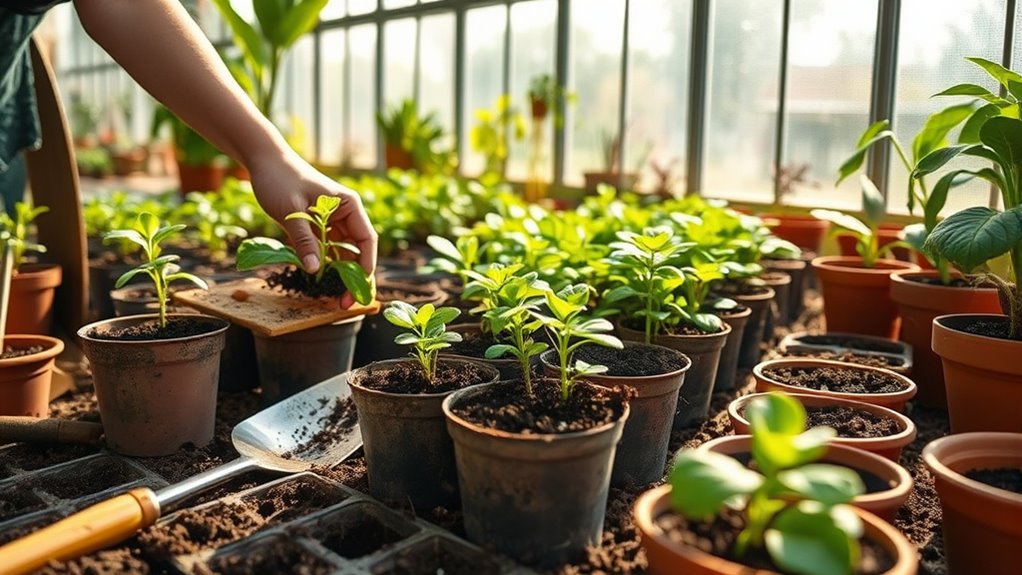
Before you transplant seedlings into your greenhouse, it's vital to prepare both the containers and the soil properly. Start by selecting plug trays or other suitable containers that provide adequate space for root growth and have proper drainage holes to prevent waterlogging. Sterilize these containers to avoid disease transmission.
Next, focus on the soil. Use a high-quality potting mix enriched with sphagnum moss and perlite, ensuring it retains moisture while promoting drainage. Incorporate organic matter like compost to enhance soil fertility and structure.
Check the pH levels to match the needs of your specific seedlings. Maintaining ideal soil moisture during preparation is critical for reducing transplant shock and ensuring healthy growth.
Handling Seedlings With Care
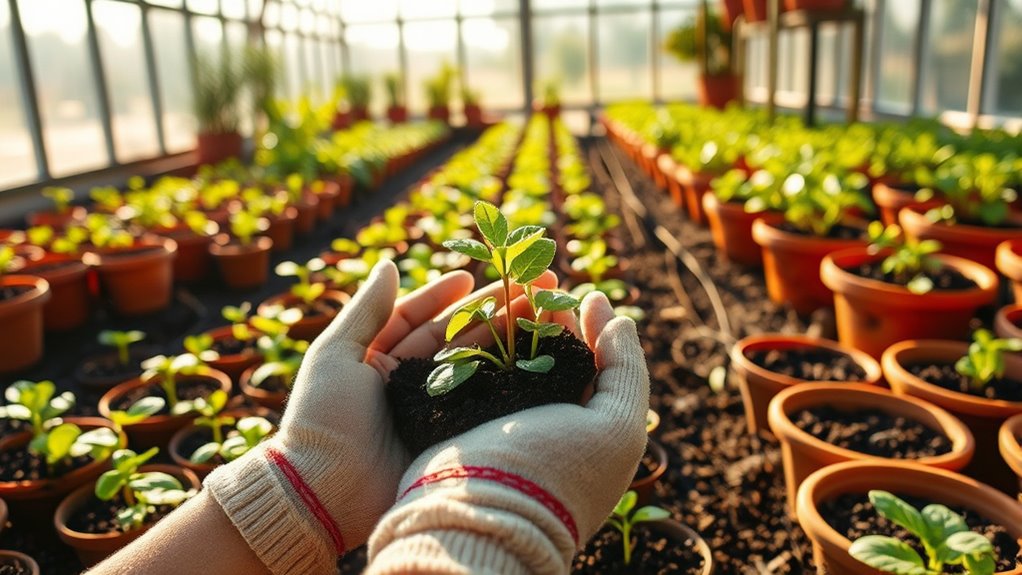
Handling seedlings with care is essential to their successful transplanting and growth. Always grasp seedlings gently by their leaves to avoid damaging the stems.
Before transplanting, confirm your seedlings are well-watered; this reduces stress and helps them adapt better. Use tools like a widger to separate seedlings without harming their delicate roots.
Ensure your seedlings are well-hydrated before transplanting to ease stress and promote healthy adaptation. Use a widger for gentle separation.
Be mindful of temperature conditions—transplant during ideal times, ideally in the early morning, especially in hot climates. Additionally, limit handling to minimize root disturbance and guarantee the soil is well-prepared and aerated.
Gradually expose seedlings to outdoor conditions to prevent transplant shock. With these careful steps, you'll set your seedlings up for a thriving life in your greenhouse.
Techniques for Effective Transplanting
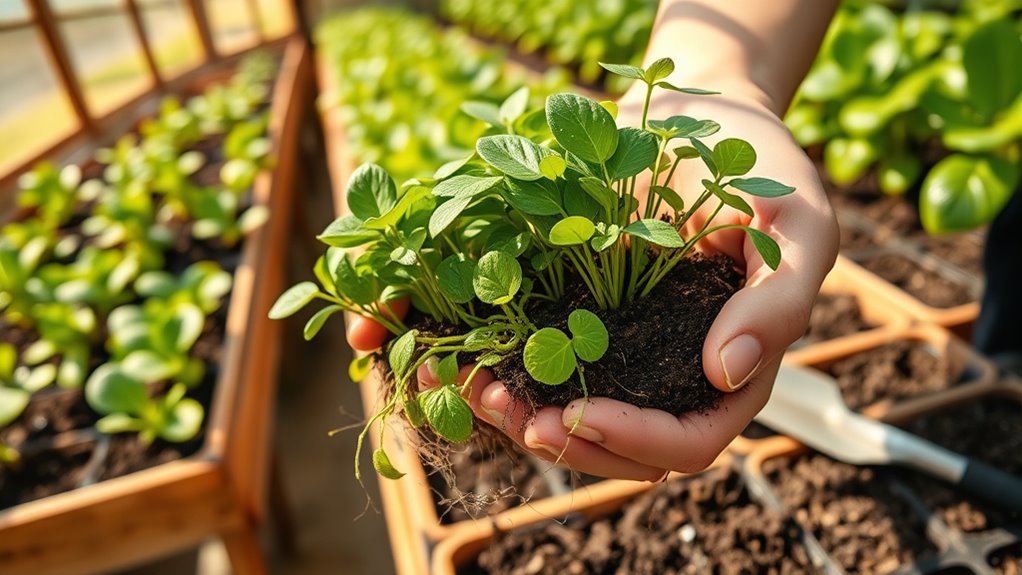
Transplanting seedlings effectively requires careful planning and execution to guarantee their successful establishment in your greenhouse.
Start by timing the transplant when seedlings have their first or second set of true leaves, indicating a strong root system. Choose seed starting trays or pots with drainage holes to avoid waterlogging. Use high-quality, organic potting soil to promote growth.
When transplanting, handle seedlings gently by the leaves and loosen the germination medium around their roots. Create dibble holes in the growing medium for precise placement. For efficiency, consider using prefilled flats or transplanting machines.
Finally, maintain ideal temperature and humidity in your greenhouse to reduce transplant shock, ensuring your seedlings thrive in their new environment.
Post-Transplant Care and Monitoring
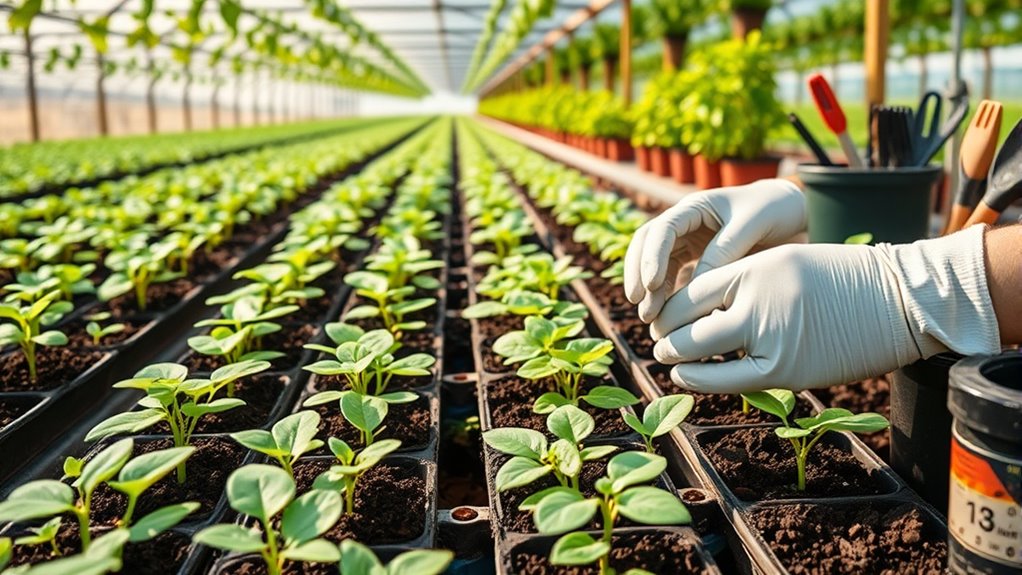
Once your seedlings are safely transplanted into the greenhouse, it's crucial to focus on their post-transplant care and monitoring to guarantee they thrive.
Regular inspections for pests and diseases help you catch any issues early. Manage moisture carefully; keep it consistent but avoid overwatering to prevent root rot.
Maintain ideal temperature ranges suited to each plant species, and guarantee good air circulation to deter fungal diseases. Adjust light levels as needed, using shading to prevent scorching.
Monitor soil quality and pH, applying balanced fertilizers after the initial transplant period. Additionally, energy efficiency ratings can guide you in optimizing the greenhouse environment, ensuring your plants grow in the best conditions possible.
Finally, keep detailed records of your plants' growth and any treatments applied to inform future decisions in your greenhouse management.
Enhancing Greenhouse Efficiency for Seedling Growth

To enhance the efficiency of your greenhouse for seedling growth, you'll want to create an environment that meets the specific needs of your plants.
Start by selecting a greenhouse suited to your local climate—insulated for colder areas or ventilated for warmer ones. Use materials like glass for ideal light transmission and reflective surfaces to control temperature.
Implement energy-efficient practices, such as utilizing seedling carts to conserve energy. Control temperature and humidity with appropriate systems, and maintain a sturdy structure to withstand weather challenges.
For seedlings, use well-draining potting mixes and efficient irrigation systems.
Finally, monitor your greenhouse environment with thermometers and hygrometers to guarantee your seedlings thrive.
Frequently Asked Questions
What Types of Seedlings Are Best Suited for Greenhouse Transplanting?
When choosing seedlings for greenhouse transplanting, consider varieties like cucumbers and sweet melons, which thrive after a short period of growth.
Chili peppers and eggplants need more time, so plan accordingly. Tomatoes are also great options, maturing in about 50-55 days.
Make certain you select seedlings with the right number of leaves for their type, as this indicates readiness for a successful transplant.
Keep an eye on environmental conditions for the best results.
How Long Should Seedlings Be Kept in Containers Before Transplanting?
Imagine peering into your garden, keen for vibrant growth.
You'll want to keep your seedlings in their containers for about 2-3 weeks in smaller trays and 3-4 weeks in larger ones.
Watch closely for those true leaves; they're your signal.
If they're around 2-3 inches tall with two sets of true leaves, it's time to reflect on transplanting.
Wait too long, and you risk stunted growth or root-bound issues.
Can I Transplant Seedlings During Rainy Weather?
Yes, you can transplant seedlings during rainy weather, and it often has benefits. The natural moisture helps reduce the stress on your plants, keeping the soil adequately moist.
However, be cautious of excessive wetness, as it can lead to root rot. Make sure the soil drains well and monitor conditions to prevent waterlogging.
If done right, you can take advantage of the rain to support your seedlings' healthy growth.
What Common Mistakes Should I Avoid When Transplanting Seedlings?
Think of transplanting seedlings like a delicate dance; one misstep can lead to disaster.
To avoid common mistakes, make certain you time it right, harden seedlings off gradually, and use proper tools.
Prepare your soil well, and choose the right container size.
Handle seedlings gently, monitor their moisture, and provide adequate support.
Finally, keep an eye on their health post-transplant—neglecting any of these can spell trouble for your green companions.
How Can I Tell if My Seedlings Are Ready for Transplanting?
To tell if your seedlings are ready for transplanting, look for at least two sets of true leaves and a height of 2-3 inches.
Make certain their root systems are well-developed, but not overcrowded.
Check for legginess, which indicates they might need more light or space.
Also, watch for yellowing leaves, as this signals nutrient deficiencies.
Finally, verify the outdoor conditions are suitable for transplanting before making the move.
Conclusion
Transplanting seedlings into your greenhouse can feel challenging, but with the right timing and preparation, it's a rewarding experience. As you nurture delicate roots, remember the strength they'll gain in their new home. While you handle each seedling with care, envision the vibrant growth that follows. Balancing attention and patience, you'll cultivate a thriving environment. In the end, your hard work transforms fragile beginnings into flourishing plants, creating a lush oasis that thrives under your dedicated watch.


